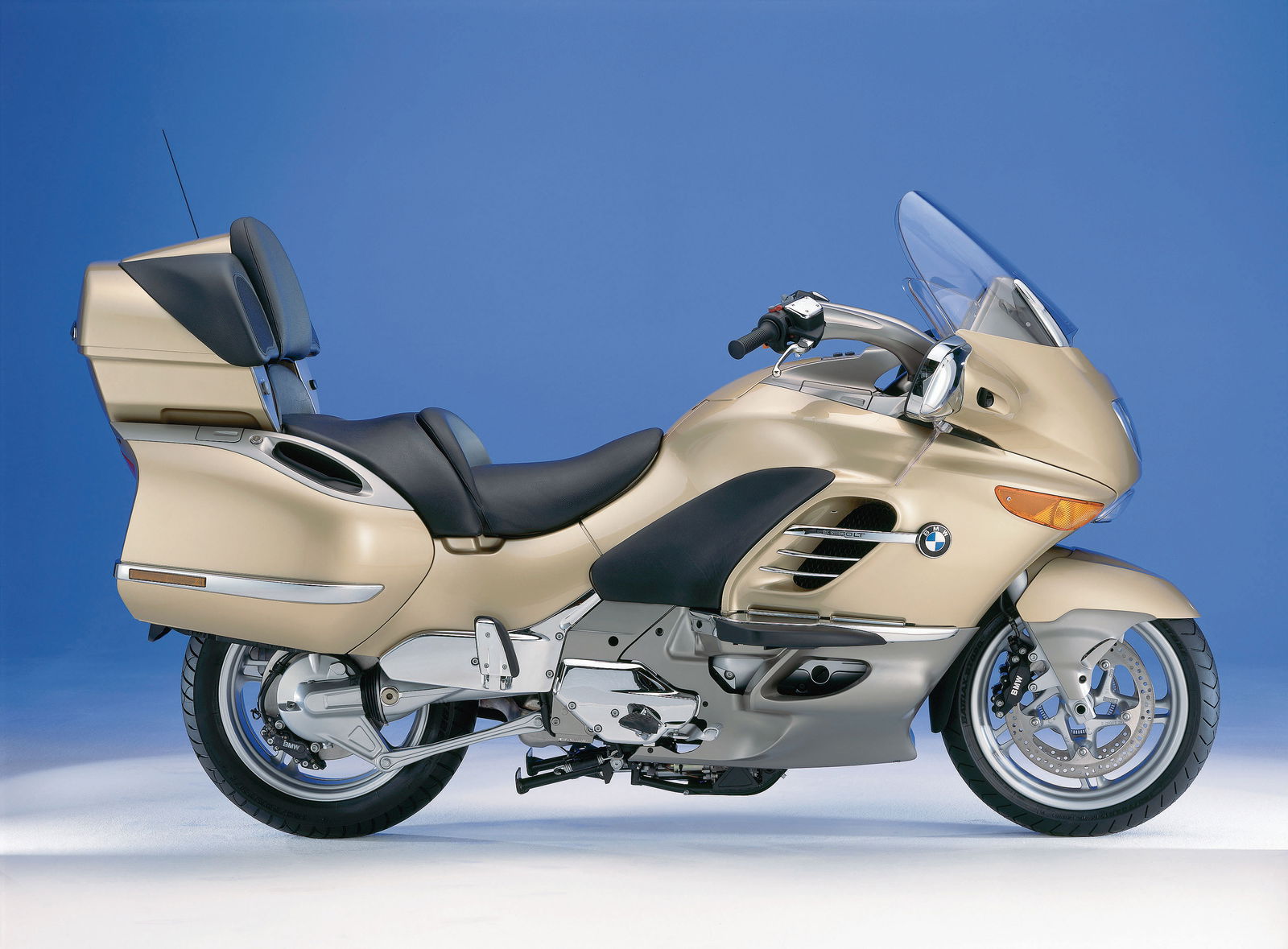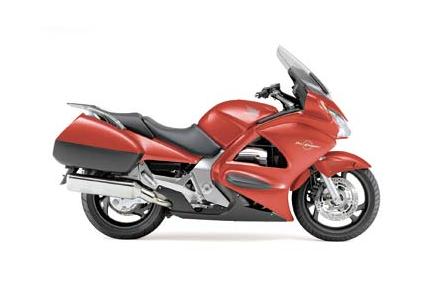K1200GT (2003 - 2005) review
The GT is very comfortable in a straight line, comes with colour-coded panniers as standard and is solid at speed. The suspension isn’t the best, ground clearance is limited and acceleration is very poor

The BMW’s K1200GT is basically a restyled K1200RS. The four cylinder motor itself can trace its roots to 1983, when the horizontal
inline-four engine first appeared in the K100. Back then it was only 987cc, but over the course of the next 20 years it gained a sixth gear, kept the shaft drive and developed into its current 1171cc capacity.
In the GT, the engine has received another tweak to make it the most powerful BMW has ever made. With a claimed 130bhp and 86ft-lb of torque the motor sounds like it should be the answer to every touring rider’s dreams. Unfortunately, reality is somewhat different.
Basically, the motor is a slug. It’s torquey, and will pull cleanly from as low as 2000rpm in top gear, but it is slow to build up any head of steam and there’s no discernible powerband at all. Overtaking a car doing 70mph I pulled out and opened the throttle in top gear expecting the engine to give me a decent burst of acceleration, but all I got was a gentle build up of speed. As the approaching lorry got closer, I dropped down two gears, only to be greeted by the same acceleration, at higher revs.
Given a large run up, it’s fast. In a tussle with a Spanish Honda NSX the GPS system was reading a genuine 147mph but it takes so long to get there it becomes almost irrelevant.
A lot of this is due to the immense weight of the bike. At 285kg it’s 10kg heavier than Honda’s Pan European and 50kg heavier than Yamaha’s FJR, which is a hell of a disadvantage not only for acceleration but also the handling. Through the twisty mountain roads the GT is slow to change direction and suffers from a lack of ground clearance. With the pegs on the lowest of the two settings they touch down easily with just the rider on board, and can even ground on the motorway should you hit a bump while leant over. Okay, it only takes a few seconds to adjust the pegs to the higher setting but then you are compromising on comfort.
Also, from stock, the suspension is set to accommodate a fat German, his fat wife, panniers full of lederhosen and several large bratwursts – which is much too hard. The best solution is to reduce the spring preload via the handily-placed adjustor, and then up the compression damping. Even with this, the front feels vague when cornering at speed and isn’t very confidence-inspiring at all.
That said, the GT is very good at covering large distances effortlessly. I can honestly say the GT is the comfiest bike I have ever ridden. The seating position is close to perfection, with the seat itself full of padding, and the bars at just the right height to stop aches and pains in your wrists. I covered over 600 miles of dual carriageway in a day and got off the bike at the end feeling fine and ready for a night on the beers, not a session with a chiropractor.
One of the main differences between the RS and GT is the fairing which has air scoops on the GT to deflect the air around the rider’s legs and hands. These not only deflect wind but also rain away from your body keeping you dry and warm. Also, you get as standard a two-height adjustable seat, a plug-in point for heated clothing etc, an electrically-adjustable screen and optional extras including a heated seat, cruise control and heated grips.
But it’s not all plain sailing. Being over six feet tall I found that the screen was too low, even on the highest setting, and I had to hunch to stop my head getting a buffeting, although a taller screen is an optional extra. Also, at a steady 90mph the tank only went for around 140 miles between fill-ups, which isn’t very good for a tourer.
The standard servo-assisted ABS brakes are extremely powerful but lack a bit in feel. As I rounded a corner I was greeted by a local goat herd as it crossed the road which meant some serious braking to avoid incurring the wrath of their keeper. The ABS helped me come to a complete halt, very rapidly and in total safety – even amid the crap on the road. This is brilliant in emergencies but for normal road riding I found the initial feeling when the servo kicked in a little odd.
The BMW’s K1200GT is basically a restyled K1200RS. The four cylinder motor itself can trace its roots to 1983, when the horizontal
inline-four engine first appeared in the K100. Back then it was only 987cc, but over the course of the next 20 years it gained a sixth gear, kept the shaft drive and developed into its current 1171cc capacity.
In the GT, the engine has received another tweak to make it the most powerful BMW has ever made. With a claimed 130bhp and 86ft-lb of torque the motor sounds like it should be the answer to every touring rider’s dreams. Unfortunately, reality is somewhat different.
Basically, the motor is a slug. It’s torquey, and will pull cleanly from as low as 2000rpm in top gear, but it is slow to build up any head of steam and there’s no discernible powerband at all. Overtaking a car doing 70mph I pulled out and opened the throttle in top gear expecting the engine to give me a decent burst of acceleration, but all I got was a gentle build up of speed. As the approaching lorry got closer, I dropped down two gears, only to be greeted by the same acceleration, at higher revs.
Given a large run up, it’s fast. In a tussle with a Spanish Honda NSX the GPS system was reading a genuine 147mph but it takes so long to get there it becomes almost irrelevant.
A lot of this is due to the immense weight of the bike. At 285kg it’s 10kg heavier than Honda’s Pan European and 50kg heavier than Yamaha’s FJR, which is a hell of a disadvantage not only for acceleration but also the handling. Through the twisty mountain roads the GT is slow to change direction and suffers from a lack of ground clearance. With the pegs on the lowest of the two settings they touch down easily with just the rider on board, and can even ground on the motorway should you hit a bump while leant over. Okay, it only takes a few seconds to adjust the pegs to the higher setting but then you are compromising on comfort.
Also, from stock, the suspension is set to accommodate a fat German, his fat wife, panniers full of lederhosen and several large bratwursts – which is much too hard. The best solution is to reduce the spring preload via the handily-placed adjustor, and then up the compression damping. Even with this, the front feels vague when cornering at speed and isn’t very confidence-inspiring at all.
That said, the GT is very good at covering large distances effortlessly. I can honestly say the GT is the comfiest bike I have ever ridden. The seating position is close to perfection, with the seat itself full of padding, and the bars at just the right height to stop aches and pains in your wrists. I covered over 600 miles of dual carriageway in a day and got off the bike at the end feeling fine and ready for a night on the beers, not a session with a chiropractor.
One of the main differences between the RS and GT is the fairing which has air scoops on the GT to deflect the air around the rider’s legs and hands. These not only deflect wind but also rain away from your body keeping you dry and warm. Also, you get as standard a two-height adjustable seat, a plug-in point for heated clothing etc, an electrically-adjustable screen and optional extras including a heated seat, cruise control and heated grips.
But it’s not all plain sailing. Being over six feet tall I found that the screen was too low, even on the highest setting, and I had to hunch to stop my head getting a buffeting, although a taller screen is an optional extra. Also, at a steady 90mph the tank only went for around 140 miles between fill-ups, which isn’t very good for a tourer.
The standard servo-assisted ABS brakes are extremely powerful but lack a bit in feel. As I rounded a corner I was greeted by a local goat herd as it crossed the road which meant some serious braking to avoid incurring the wrath of their keeper. The ABS helped me come to a complete halt, very rapidly and in total safety – even amid the crap on the road. This is brilliant in emergencies but for normal road riding I found the initial feeling when the servo kicked in a little odd.
| Length (mm) | 2250 |
| Width (mm) | 920 |
| Height (mm) | 1340 |
| Dryweight (kg) | 281 |
| Seats | 0 |
| Seat Height (mm) | 790 |
| Suspension Front | BMW Motorrad Telelever; stanchion diameter 35 mm, central strut |
| Suspension Rear | Die-cast aluminium single-sided swinging arm with BMW Motorrad Paralever; central strut, |
| Adjustability Rear | Spring pre-load adjustable to continuously variable levels by means of hydraulic handwheel, rebound damping adjustable |
| Wheels Front | 3.50 x 17 |
| Wheels Rear | 5.50 x 17 |
| Tyres Front | 120/70 ZR 17 |
| Tyres Rear | 180/55 ZR 17 |
| Brakes Front | EVO-brake system with dual disc, floating brake di |
| Brakes Rear | Single disc brake, diameter 285 mm, 2-piston fixed |
| Tank Capacity (litres) | 21 |
| Chassis | Bridging frame consisting of die-cast aluminium, engine decoupled from vibration through bearings |
| Cubic Capacity (cc) | 1171 |
| Max Power (bhp) | 130 |
| Max Power Peak (rpm) | 8750 |
| Torque (ft/lb) | 86 |
| Torque Peak (rpm) | 6750 |
| Bore (mm) | 70.5 |
| Stroke (mm) | 75 |
| Valve Gear | two cam |
| Compression Ratio | 11.5 |
| Valves Per Cylinder | 4 |
| Cooling | Water cooled |
| Fuel Delivery | Electronic intake pipe injection |
| Stroke Type | Four Stroke |
| Drive | Shaft |
| Top Speed |

